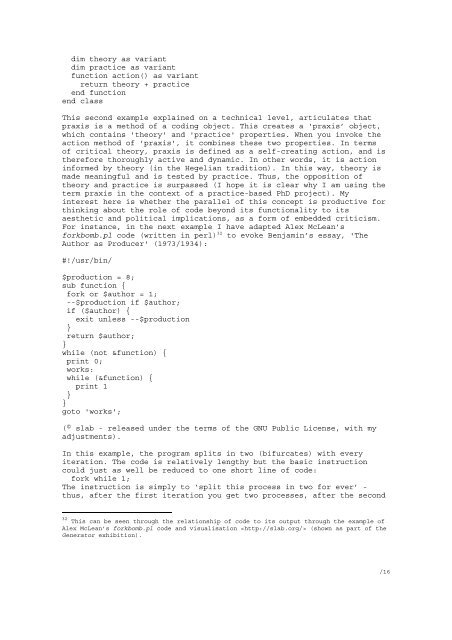anti-thesis: the dialectics of generative art (as praxis) - Geoff Cox
anti-thesis: the dialectics of generative art (as praxis) - Geoff Cox
anti-thesis: the dialectics of generative art (as praxis) - Geoff Cox
You also want an ePaper? Increase the reach of your titles
YUMPU automatically turns print PDFs into web optimized ePapers that Google loves.
dim <strong>the</strong>ory <strong>as</strong> variant<br />
dim practice <strong>as</strong> variant<br />
function action() <strong>as</strong> variant<br />
return <strong>the</strong>ory + practice<br />
end function<br />
end cl<strong>as</strong>s<br />
This second example explained on a technical level, <strong>art</strong>iculates that<br />
<strong>praxis</strong> is a method <strong>of</strong> a coding object. This creates a ‘<strong>praxis</strong>’ object,<br />
which contains '<strong>the</strong>ory' and 'practice' properties. When you invoke <strong>the</strong><br />
action method <strong>of</strong> '<strong>praxis</strong>', it combines <strong>the</strong>se two properties. In terms<br />
<strong>of</strong> critical <strong>the</strong>ory, <strong>praxis</strong> is defined <strong>as</strong> a self-creating action, and is<br />
<strong>the</strong>refore thoroughly active and dynamic. In o<strong>the</strong>r words, it is action<br />
informed by <strong>the</strong>ory (in <strong>the</strong> Hegelian tradition). In this way, <strong>the</strong>ory is<br />
made meaningful and is tested by practice. Thus, <strong>the</strong> opposition <strong>of</strong><br />
<strong>the</strong>ory and practice is surp<strong>as</strong>sed (I hope it is clear why I am using <strong>the</strong><br />
term <strong>praxis</strong> in <strong>the</strong> context <strong>of</strong> a practice-b<strong>as</strong>ed PhD project). My<br />
interest here is whe<strong>the</strong>r <strong>the</strong> parallel <strong>of</strong> this concept is productive for<br />
thinking about <strong>the</strong> role <strong>of</strong> code beyond its functionality to its<br />
aes<strong>the</strong>tic and political implications, <strong>as</strong> a form <strong>of</strong> embedded criticism.<br />
For instance, in <strong>the</strong> next example I have adapted Alex McLean’s<br />
forkbomb.pl code (written in perl) 32 to evoke Benjamin’s essay, 'The<br />
Author <strong>as</strong> Producer' (1973/1934):<br />
#!/usr/bin/<br />
$production = 8;<br />
sub function {<br />
fork or $author = 1;<br />
--$production if $author;<br />
if ($author) {<br />
exit unless --$production<br />
}<br />
return $author;<br />
}<br />
while (not &function) {<br />
print 0;<br />
works:<br />
while (&function) {<br />
print 1<br />
}<br />
}<br />
goto 'works';<br />
(© slab - rele<strong>as</strong>ed under <strong>the</strong> terms <strong>of</strong> <strong>the</strong> GNU Public License, with my<br />
adjustments).<br />
In this example, <strong>the</strong> program splits in two (bifurcates) with every<br />
iteration. The code is relatively lengthy but <strong>the</strong> b<strong>as</strong>ic instruction<br />
could just <strong>as</strong> well be reduced to one short line <strong>of</strong> code:<br />
fork while 1;<br />
The instruction is simply to ‘split this process in two for ever’ -<br />
thus, after <strong>the</strong> first iteration you get two processes, after <strong>the</strong> second<br />
32 This can be seen through <strong>the</strong> relationship <strong>of</strong> code to its output through <strong>the</strong> example <strong>of</strong><br />
Alex McLean’s forkbomb.pl code and visualisation (shown <strong>as</strong> p<strong>art</strong> <strong>of</strong> <strong>the</strong><br />
Generator exhibition).<br />
/16


